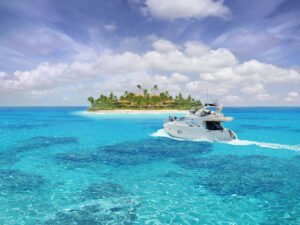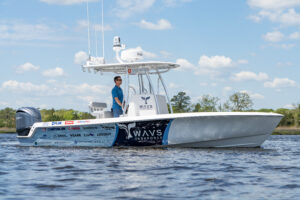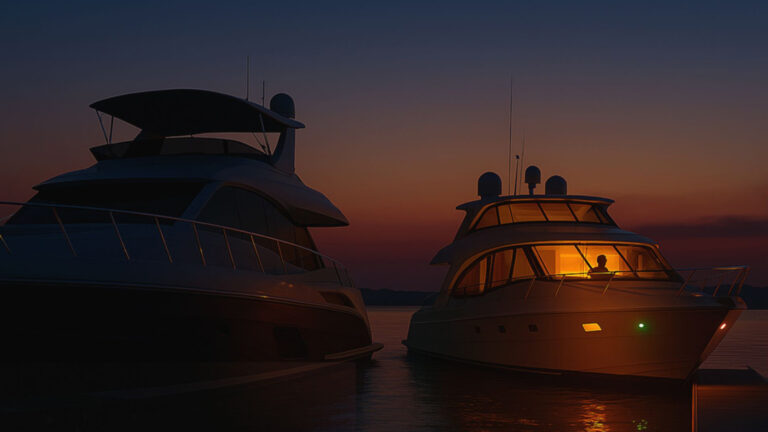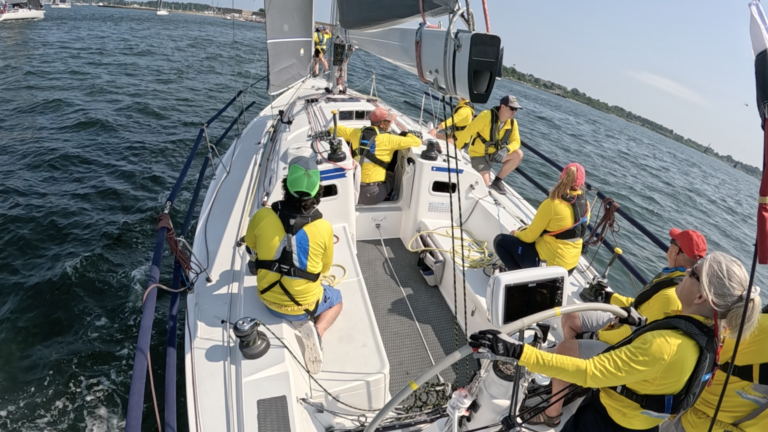The remnants of Hurricane Frances tests a lone sailor as it sweeps through the Chesapeake Bay
The Labor Day weekend cruise started off mildly enough, with me whistling for wind on a Saturday, which was answered by the wind whistling its own tune through the rigging the next two days. Chesapeake Bay was churned up to the tune of a white-capped polka chop on that Sunday and Monday, thanks to the remnants of Hurricane Frances.
But too late was not late, as the saying goes, when the wind finally came to disrupt weather patterns from Florida to Maryland. As long as a brisk breeze arrives from a favorable direction, as it did that Sunday, I’ll deal with it as much as my stamina and that of my stout pocket cruiser allows.
(After that weekend I know now that my 1962 Sailmaster 22 will outlast me long after I head off toward the sunset — in another 20 years or so — because I take better care of this boat than I do of myself.)
That Saturday, with a light wind out of the northeast and shifting to the east, I opted for Oxford once again on Maryland’s middle Eastern Shore when departing Annapolis. But the breeze soon began to die going through Poplar Island Narrows, and died even more once through Knapps Narrows and into the Choptank River, where it often seems to get a new life.
I dragged along my Walker Bay dinghy and two 5-gallon containers of gas on either deck, and entered Oxford’s Town Creek to raft up next to a large, covered, neglected old wooden sailboat with no mast. This boat has not moved from its perpetual outside dock in the 20 years I have been coming to Cutts & Case Shipyard in Oxford. I’m coming to think it is here strictly for my use.
Before again strolling around this charming shipyard of wooden sailboats, I put out appropriate fenders. A short walk led to my favorite restaurant, the Mill Street Grill, where I ordered crab soup, and crab balls that I broke up into the soup to turn it into a lumpy crabmeat stew.
Then it was back to the boat with a cigar and to anchor out in the river off The Strand.
For 10 years I have used Anchorlina, a jack strap anchor rode on a reel attached to the port bow pulpit stanchion. But after adding a Schaefer Snapfurl roller furling system, things were just too busy on the foredeck, also occupied by a hanging Danforth anchor. (Many boaters mistook this rig for a garden hose reel and this bothered me for years.)
So I went back to a traditional chain and rode that feeds through the hawse pipe into the anchor locker, a system that always worked in the past.
But as I put the outboard in neutral and prepared to lower the anchor, I neglected to lay out the chain on deck beforehand with the shackled rope end clear and ready to run free. Well, the chain came out but somehow the rope-to-chain end jammed under the deck.
Being alone, I had to leave the drifting boat untended, crawl through the cabin and wiggle into the confined anchor well to free the kink that had devilishly jammed itself. Then it was back on deck for another attempt before drifting into the anchorage and arousing boaters.
Up at 7:30 the next morning, it was a grand sight to find flags flying briskly from the east so early in the morning. That was good news, as I was about to head south out of the Tred Avon River, then northwest on the Choptank River, through Knapps Narrows, and northward back to Annapolis — a cruise of about 32 miles.
It didn’t quite work out as planned.
I donned a West Marine Belt Pack Vest with a manual inflator and sailed away at 8:30 a.m., reaching Knapps Narrows at 10:30 where I dropped the main and furled the jib. Turnaround space is limited in this man-made channel and a current can be tricky, especially if the wind is also a factor — which it was.
At the Bay exit I began sailing again, but could not maintain a north heading through the Narrows without a lot of tacking with the rail down in a building breeze. So I went outside and settled down to a north-northwest heading.
Sailing close to the Poplar Island dredge fill and heading up in every lift, I was met by a wind gusting over 20 knots and felt more comfortable on a broad reach after reefing the main. I soon rolled in the jib, too, then furled it completely, changing course to the northwest and the mouth of the West River nine miles across the Bay.
In the middle of the rough, pounding Bay, the whisker pole, mounted to the mast, broke loose from two clamps and began banging. I didn’t want to risk a trip to the foredeck under sail so I just lived with the banging until rounding Curtis Point and reaching Galesville, 2-1/2 miles farther into the West River.
After firing up the outboard, furling the jib and dropping the main, I popped the pole back into place and tied up at the county dock, which was draped with crab lines like spider webs. It was 2:30 p.m. and time to walk to Pirates Cove Restaurant for a late lunch with Joe the bartender.
At 4, hoping the easterly would moderate, I decided to try for Annapolis, but it was still blowing 20-plus knots on the nose. I didn’t bother with setting any sails and, sensing a very wet, uncomfortable ride ahead, I turned into the Rhode River and to anchor in Half Moon Bay. But, wanting to get as close to land as I could, I headed instead for the protected head of Cadle Creek and sneaked into the travelift bulkhead at Casa Rio Marina, where I knew the night would be absolutely peaceful.
Around 8 p.m., lusting for hot sauerbraten and dumplings, I hitched a ride to the Old Stein Inn in nearby Edge-water. Owner Michael Selinger gave me a ride back in the 1981 Mercedes stretch limousine he’s restoring. I sat like a VIP in the rear seat and was chauffeured to the marina in style (but, alas, no one witnessed my impressive arrival).
That night I positioned my Seat Box in the cabin, poured some Cruzan black-strap navy rum into ginger beer, lit a Gloria Cubana cigar, and listened to some jazz CDs.
I was awakened at daybreak by boaters using the launching ramp and got prepared to leave in what I thought was a quiet dawn.
One look at the masthead fly, however, showed wind still blowing, but now out of the northeast — an even worse direction for me heading into it for a 12-mile windward bash to Annapolis.
Knowing that I’d be beating and tacking and getting wet, I put on a warm, long-sleeved shirt and foulies (top and bottoms) and motored off at 7:30 a.m. I made two mistakes, deciding not to raise a reefed main and forgetting to tie down the whisker pole, which would have caused a problem hoisting the main.
Entering the West River into a 20-knot, white-capped northeasterly generating a long fetch with 3-foot rollers, I powered out with no sail and immediately was stopped dead when heading directly into this heaving chop. So I began power reaching to shoulder the seas and make some progress.
At the mouth of the South River, the whisker pole came loose again and started banging. This time I had to tie it down. I put the outboard in neutral in case I was bucked off and could climb aboard the stern ladder without worrying about a turning propeller.
I cautiously creeped up to the foredeck to secure the pole as the boat settled down a bit, an action that also prevented raising the main. At first I had thought about reefing the main and then tying down the pole.
On hindsight I should have simply removed the pole before I left the dock and stowed it in the cabin since I knew I wasn’t going to be using it anyway. Also, a reefed main would have made motor-sailing much more enjoyable. As it was, I power-reached with no sail anyway, staying in the lee of Thomas Point as long as I could. I didn’t want to bother with endlessly tacking the jib alone either, winching it in and all that.
To keep a little dry and warm, I rigged my tiller extension to reach inside the cabin where I could stand protected with only my head and shoulders exposed. If the main was up and I was hit with a mild knockdown, I could not have quickly dashed back to the track aft and popped loose the mainsheet to spill the air without leaving the “cozy” cabin.
So I stayed with the power of my dependable 5-hp, 2-stroke Mercury and continued close power-tacking and close reaching. Every so often, especially when tacking, a green roller would come aboard over the bow, explode against the cabin house, and rush over my head and into the cockpit as I ducked. After a while the cockpit floorboards were floating.
Trying to round Thomas Point Shoal’s long sandbar, the seas built up as they roared to shore. But the tide was exceptionally high, so I stayed dangerously close to shore, preparing to tack away if my centerboard hit, which it never did.
The Tolly Point Shoal, the last rounding point before the mouth of the Severn River and Annapolis, was only two miles away, but it seemed like 20 because of the endless round of power tacks. (Remember, my boat is only 22 feet on deck and we were really getting slammed about.) Finally, because of the high tide, I went close in to round crabpot-laden Tolly, as close as I’ve ever gone before.
Still standing in the cabin, towing a dinghy on a short line, and ducking spray and an occasional boarding roller, I must have looked like a solo smallboat cruiser gone mad as racers headed out from Annapolis. Some hooted and waved but I was too weary even to roll out the jib. I just wanted to get into the peace and quiet of Spa Creek to change clothes and warm up.
I made the 10 a.m. opening of the Spa Creek Draw Bridge. Twelve miles in 2-1/2 hours under motor alone and pounding into those conditions seemed fairly impressive for this little boat of mine and an older outboard that refuses to quit.










